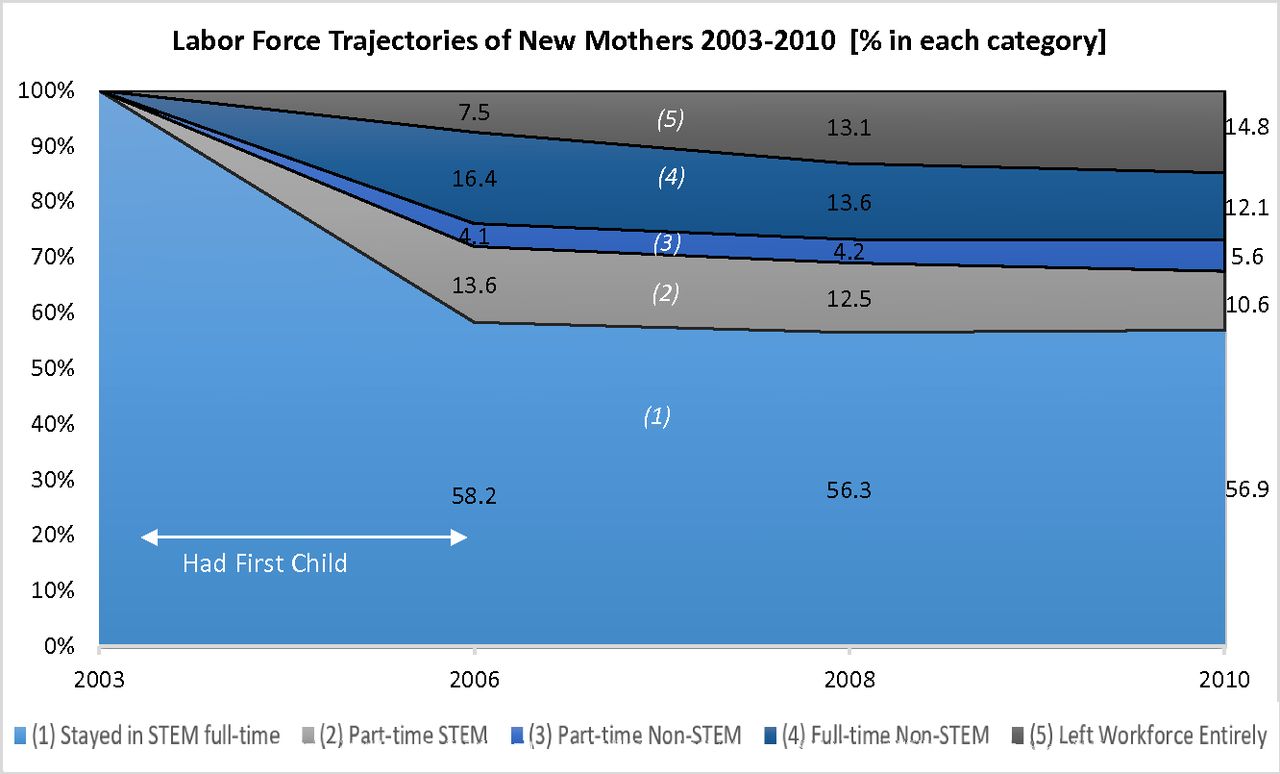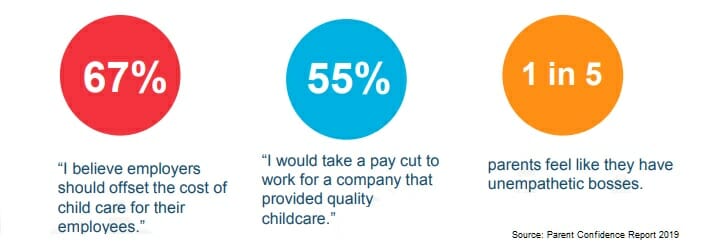People working in STEM fields — science, technology, engineering, and math — feel enormous pressure to put aside all other considerations and devote themselves solely to their work.
Family, friends, and other personal responsibilities are often seen as distractions at best, pollutions at worst. That’s why 43% of women and 23% of men leave their full-time STEM careers when they become parents, according to a new study from the National Academy of Sciences. This is a tremendous loss for the field, as well as for the parent from their chosen careers.
When viewing the total span of a career, the high-demand period of parenting is relatively short. Businesses must find ways to keep mothers and fathers engaged at work while they raise young children and to offer parents greater opportunities for advancement and leadership down the line.
STEM is often fast-paced, extremely demanding and fiercely competitive, requiring that employees be all-in, every day. Tech companies competing on a global scale promote a culture of workaholism that minimizes employees’ choices and maximizes their productivity. The net result is that promising workers often burn out early and leave the field.
Silicon Valley’s ageism problem means that companies tend to focus on recruiting people in their 20s and early 30s — when people are most likely to be having children. During the four to five years before a child is in school during the day, the physical demands of caregiving prove a major responsibility for parents and a high source of stress for mothers as they walk the tightrope between family and career.
The challenge for many parents, especially women, is not that they don’t want it all; it’s that they are asked to give it all at work. But when they do, it becomes nearly impossible to also take care of themselves, take care of family needs, and enjoy quality time together.
Supporting parents in STEM jobs
There are steps employers can take to lower turnover and retain working parents.
1. Get real about gender balance
Don’t just talk about inclusion and diversity; make a plan, set goals, and follow through. It’s not enough to just recruit and promote more women, though that’s a crucial step. Simultaneously training employees to unlearn stereotypes and overcome misconceptions — like the toxic idea that maternity leave is a vacation — is equally important. Take stock of gaps in gender balance at the workplace and provide stronger training, consultation, and communication to support re-entering the workforce after parental leave.
2. Invest in initiatives
It may take some time and money up front, but anything you can do to make it easier for employees to be home when they need to be and to comfortably integrate their parental duties into their work lives is worth the effort.
Paid family leave is becoming more common in the U.S. — and may become mandatory — which should help with retaining parents in the workforce. It’s an important place to start, but go further and invest in benefits like childcare support — something 67% of employees are seeking — or even baby bonuses.
On-site facilities should include lactation rooms for sure, but to provide real value, offer on-site childcare, as 55% of parents would accept lower salaries from a company that offers quality on-site daycare. On top of workplace amenities, provide more flexibility and telecommuting options for parents without penalty or exclusion. With almost 40% of hiring managers expecting their workforces to shift to primarily remote work in the coming decade, this initiative will be increasingly necessary to staying competitive in a job seekers’ market.
3. Reinvent the benefits package
Running a family is similar to running a small business: The tasks are never-ending. Offering a concierge program as a benefit gives working parents what they really need — more time. Most parents have little time just for themselves, so help with errand running can be invaluable.
Consider financial perks like contributing to college savings funds. Barely 1% of employers contribute to these tax-advantaged 529 plans, making it a powerful retention incentive. Get even more creative helping to subsidize relocation benefits for extended family members to help with childcare, or issuing vouchers for parents’ nights out. Some of the larger employers have special services for mothers who travel for work. These include paid for shipments of breast milk, breast milk pumps and, for either traveling parent, subsidies for child care services back home. The private equity firm KKR even pays for new parents to bring their child and a nanny on business trips.
4. Create a village
It takes a village to raise a child, but the family-based village is a thing of the past. The workplace has become the primary source of community, which is clear when businesses furnish their campuses with the kinds of amenities traditionally found in homes and neighborhoods: kitchens, gyms, laundries, car services, and grocers. In addition to these creative corporate concierge perks, try to make the surrounding community a viable place for families to thrive, and see what the workplace can do to support affordable options for housing, higher education, and high-quality childcare.
It is absolutely possible for STEM workers of any gender to be both devoted parents and productive workers. Ultimately, this is not a “mommy” issue. This is a systemic issue, a widespread cultural challenge for businesses to find a way to compete in a global economy while prioritizing employees’ personal and family well-being.
